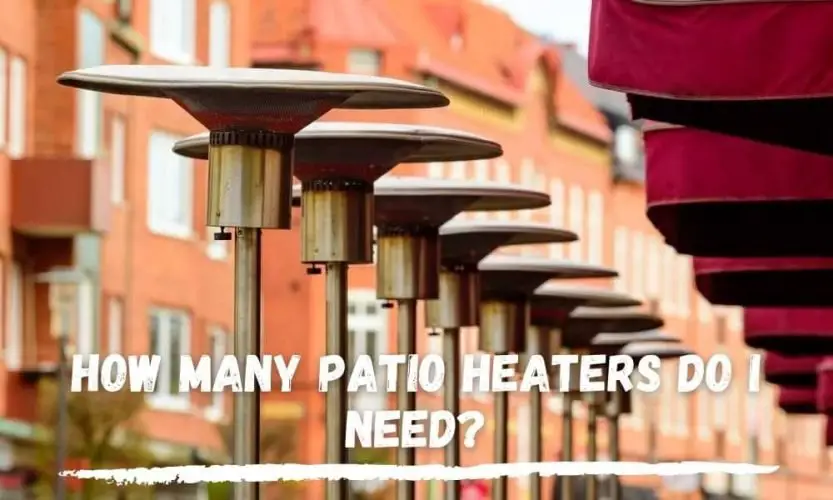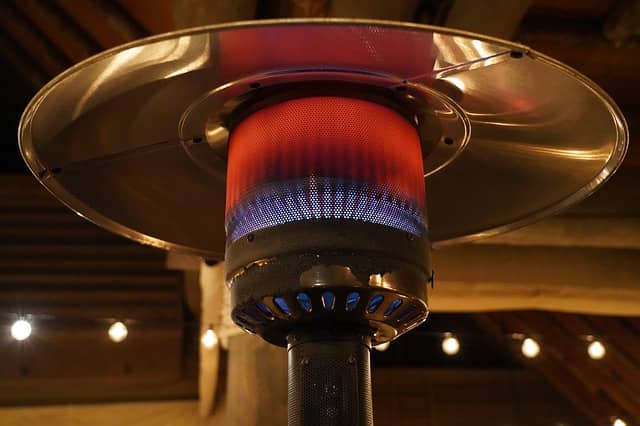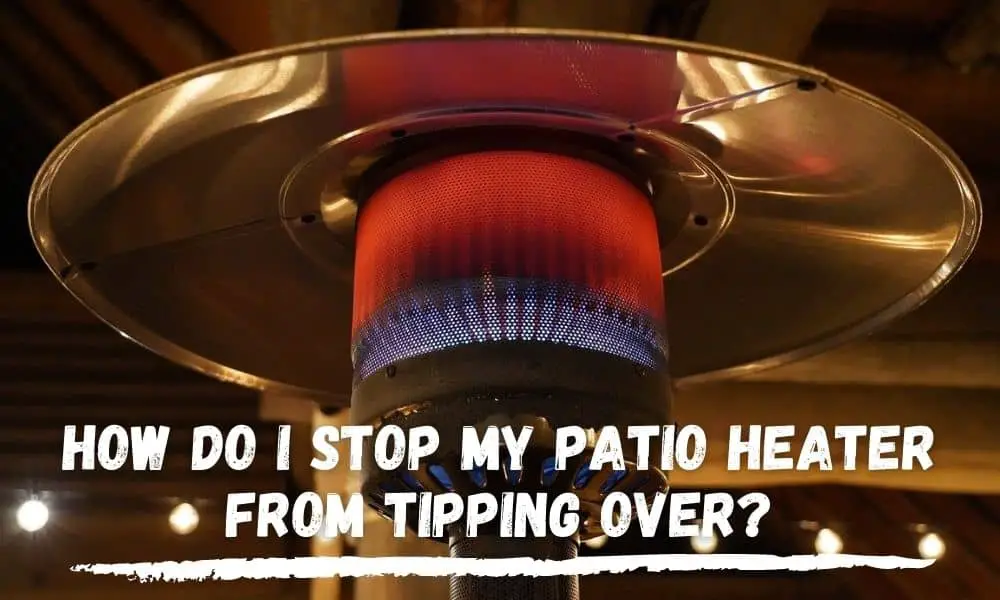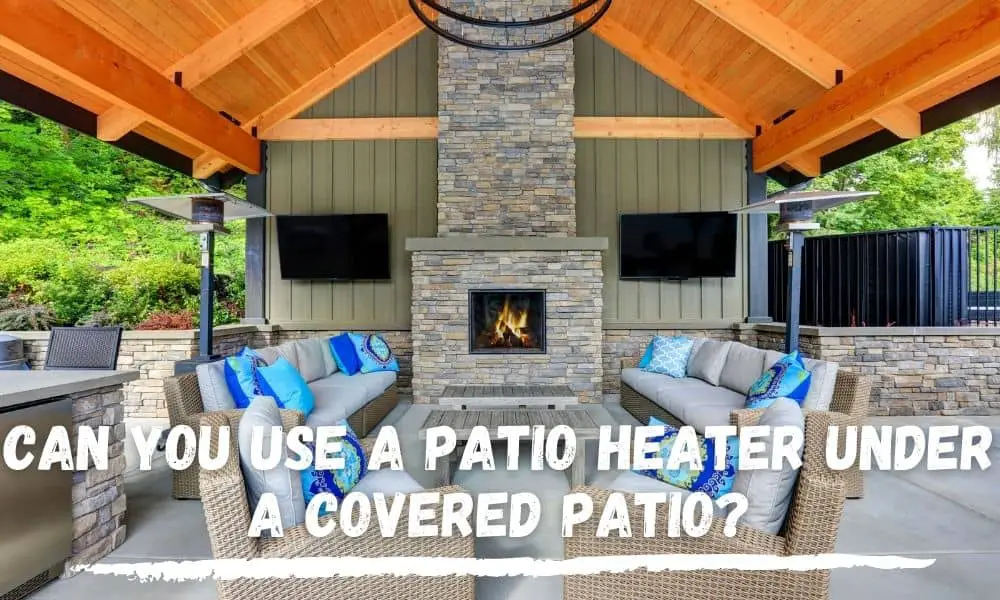The number of patio heaters you need depends on several factors ranging from the size of your patio, how much space you want to heat, the things in your home to the degree to which you want to warm it up.

The question “How many patio heaters do I need?” is asked often. You need one patio heater for every 1500-2000 square feet of covered space. For uncovered patios, you need one freestanding patio heater for roughly around 314 square feet of space.
Quick Navigation
Are Patio Heaters Worth It?
If you are looking to purchase a patio heater, you should ensure that the device you buy is worth your money. Besides, you are supposed to make sure that you don’t spend your income on a heater that won’t meet all your specific needs for all seasons.
You should consider different factors to make an informed investment that fully suits you and your family. For example, the size of the propane tank, customer service of the company, the size of your home, evaluate the pros and cons to even free shipping.
Now: One of the essential questions you should ask yourself when buying a heater is whether it will withstand the harsh winter season or the heater will only be used to generate ample heat to warm up during the lesser summer night chills.
To determine this, you need to consider the type of patio heater you are looking to purchase.
1. Gas and Propane Patio Heaters
If you are looking to buy patio heaters that can put off a significant amount of heat, consider gas or propane-powered heaters. These heaters use natural gas and use propane tanks as a fuel source to heat a sizable outdoor space.
For instance, one patio heater can keep your family warm during summer nights when the night breeze starts to get quite chilly.

If you want to purchase gas patio heaters that can be used in the winter season, gas and propane patio heaters are the best options. Many patio heaters that generate heat using natural gas can accumulate more heat energy to put out to help keep you and your family warm.
Therefore, with Natural gas heaters, you can utilize a fire pit if you are just you and your family or several fire pits if you are hosting many people. Gas fire pits have to be connected to a natural gas line.
On the other hand, you need to ensure that the amount of space you want to warm with one fire pit or heater is not too large. You should also avoid using a gas-powered patio heater in an enclosed space. This can be potentially dangerous to your health.
Avoid using gas-powered heaters in an enclosed area to minimize the chances of fire hazards. Natural gas heaters are the safest patio heaters you can use for your outdoor space.
2. Electric Patio Heaters
Electric patio heaters are gaining more popularity thanks to the recent styles and innovations that have seen them become more powerful.
However, it is also important to note that most electric patio heaters are not as strong as gas and propane heaters. In many cases, the heat generated by most electric patio heaters is considered “softer” than that caused by the gas or propane patio heaters.
If you are looking to purchase an electrically powered heater to generate a significant amount of heat enough for your standing patio, then you are in luck. Electric patio heaters can generate enough heat to warm you and your family up during the summer.
But, if you want to use an electric-powered heater to keep you and your family warm during winter, you might not be so lucky. Winter is not conducive for many patio heaters since many fire pits cannot generate enough warmth due to the surroundings.
It is not certain whether this model can generate enough heat to keep your family warm.
Turns out, there is one case scenario that’s an exception. You might be luckier with an electric-powered heater if you use it to provide enough warmth for a screened-in or indoor patio. This kind of environment will help you maintain all the heat generated by the electric heaters in one place, which will warm the surroundings up faster and also help them keep the warmth.
Another vital point to note is that the most appropriate space to use these heaters is an enclosed patio.
If you choose gas or propane heaters in such surroundings, you risk creating a potential fire hazard, given that the open flames might spark and cause other stuff in the room to blaze. Some heaters also emit carbon monoxide.
3. Infrared Patio Heater
Thanks to the recent design trends, styles, and technology innovations, you can opt for an infrared heater. These heaters are very efficient at generating warmth and are available in models that can hang from the wall.
One outstanding advantage to the infrared patio heaters is their ability to use their power to provide enough warmth throughout a room in the most efficient way.
They operate by using infrared technology similar to how the sun works to generate energy for particular objects. This way, the infrared patio heater can warm items and space more appropriately than most traditional heaters.
What’s even better, these heaters only need an electric source and can operate correctly in any surrounding with a suitable power source.
That’s not all, it also allows you to warm yourself and your family up during the winter, and you will generate more heat than most electric heaters.
Besides, this is the best option for you if you want to create ample warmth for enclosed or screened spaces without worrying about potential fire hazards.
4. Wood Burning Heaters
Wood burning fire pits are good for many people. However, they produce carbon, which is harmful to your health. One pound of wood is approximately 8,600 BTU, similar to heat one pound of water to one degree Fahrenheit. This is less as compared to burning one pound of propane gas.
Unlike other heaters, before using wood-burning heaters in your home, you may require clearance. Make sure to position it away from other things in your home.
The size of your home and the place you want to warm will determine the types or number of wood-burning heaters used. The place you stay, ways of getting wood, heat type to the more things and people you have, determines the number of heaters needed.
How Many Square Feet Does a Patio Heater Cover?
If you want to determine the number of patio heaters you need, you must consider how many square feet a particular patio heater covers. You can decide on the right type of patio heater based on its heat output in BTU (British Thermal Unit) and the amount of floor space you want to warm.
No matter the criteria you apply to partition your patio to fit your specific needs, you should purchase a patio heater that generates enough BTU for that particular amount of space.
However, the good news is that there are many patio heaters wall-mounted, which create room for airflow and push heat towards one direction. This way, you can arrange the heaters in a systematic order to provide warmth towards the appropriate recommendations efficiently.
Related: Best patio heater covers
This option might require you to use several heaters to cover the outdoor space fully. Another critical point to note is that you shouldn’t expect your patio heater to generate enough heat to warm up your patio. Given that there is nothing around the heater to trap hot air, your patio might still be quite chilly.
Therefore, you should only expect five or ten feet around the patio heater to feel as much warmth as inside the house. If you want to heat more spaces, you will have to get more heaters to maximize the efficiency of the heaters.
How Many BTUs Do I Need To Heat My Patio?
If you want your patio heater to be extensive enough to cover vast space, you will need to go for a patio heater with more BTUs. Depending on the shape of your patio, you can use a single heater of the appropriate power output to generate enough ample heat to warm up the entire space.
However, when you have mega outdoor parties with people scattered all over your patio, you can use one heater. The patio heater you choose has to be extensive enough to generate enough heat to warm up the whole patio.
The list below can help you determine the exact amount of BTU (British Thermal Units) you require to warm up certain outdoor spaces. All you have to do is take the square footage of your patio and look for the corresponding BTU.
You can use this information as a buying guide to making an informed decision when looking for the appropriate patio heater. The measurements are in terms of square feet with the corresponding BTU:
| Area (square feet) | Estimate BTUs |
|---|---|
| 100-150 | 5,000 |
| 150-250 | 6,000 |
| 250-300 | 7,000 |
| 300-350 | 8,000 |
| 350-400 | 9,000 |
| 400-450 | 10,000 |
| 450-550 | 12,000 |
| 550-700 | 14,000 |
| 700-1,000 | 18,000 |
| 1,000-1,200 | 21,000 |
| 1,200-1,400 | 23,000 |
| 1,400-1,500 | 24,000 |
| 1,500-2,000 | 30,000 |
| 2,000-2,500 | 34,000 |
The above information is based on the assumption that you are heating from a freestanding patio heater unit that radiates heat energy in a circle. If your patio is made up of cloves or spaces separated, you might require two or even more patio heaters to generate ample heat to warm up the entire area.
In such a case, you may decide to treat separate spaces in the patio as a full patio and take note of the measurements in square footage for those sections, then go for a patio heater with the appropriate BTU.
How Much Overhead Clearance Do I Need For A Patio Heater?
Your heater should have overhead clearance on all its sides. For maximum efficiency, you should ensure that there are three feet above the patio heater unit and two feet on both sides of the unit. Patio heaters are a great way to extend comfort in your uncovered areas, just like under roofs.
Provided these portable products are made with adequate vertical clearance to meet the company’s safety standards, some types of patio heaters, such as the mushroom heaters, offer the strength and endurance to fit in various areas.
If you are worried about stopping your patio heater from tipping over, you can secure the stem to a sturdy structure.
Alternatively, if you have any pillars in your outdoor area, you can wrap a small ratchet strap around it and your heater. This should be able to keep your heater vertically firm.
Conclusion
Determining the ultimate number of space heaters to perfectly suit you and your family’s needs can be a challenging process.
You should keep all this information in mind and read more articles to ensure that you shop for the right number of patio heaters for you and your family.
You should also ensure to go for a heater that works well with your specific space besides visual aesthetics.
These guidelines will help you purchase the right quantity and quality of patio heaters to perfectly suit your needs and allow you to relax on your patio comfortably, even on a chilly night during winter.




